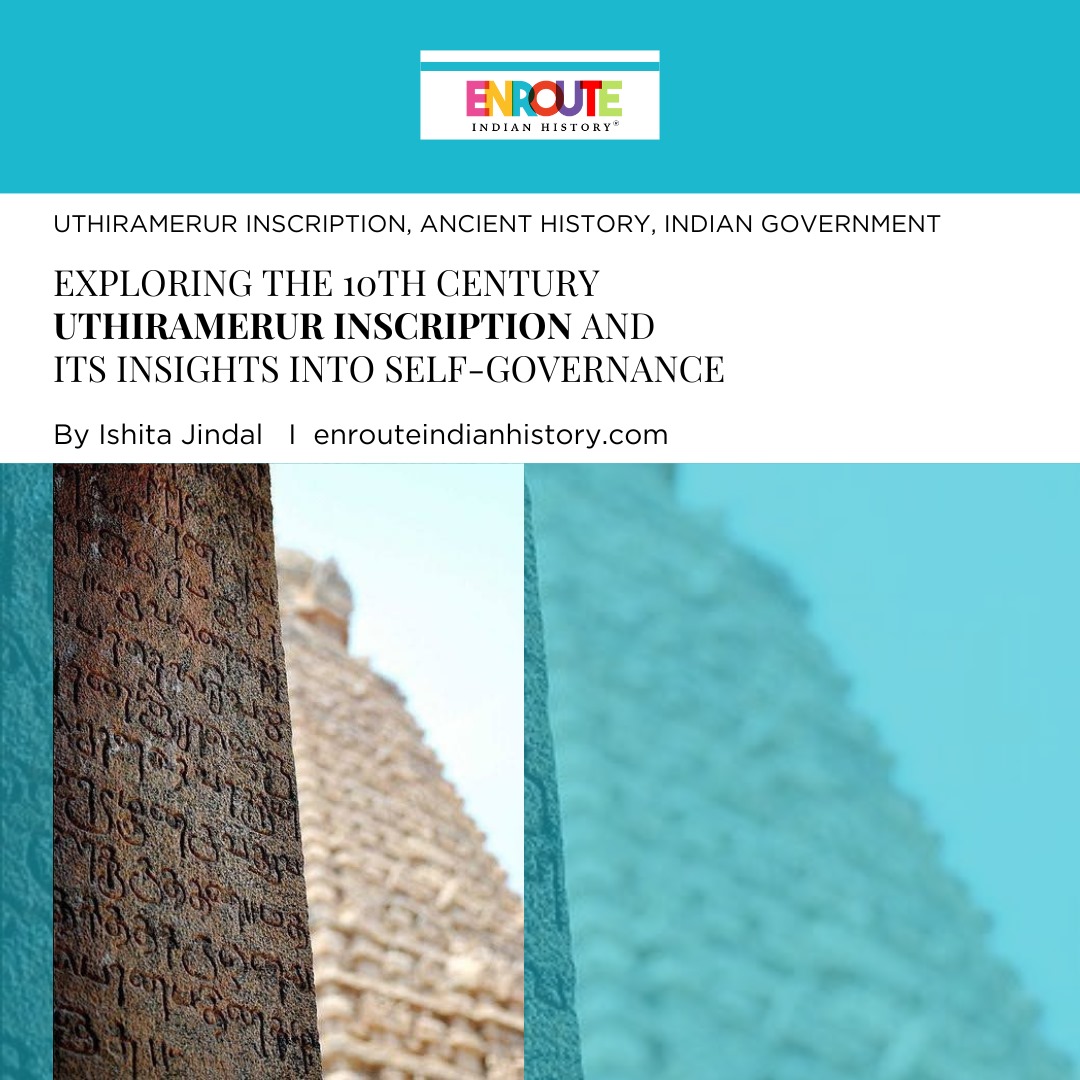Namo Anjaneyam: A Journey To The Unique Temples Of Lord Hanuman In India
- enrouteI
- April 25, 2024
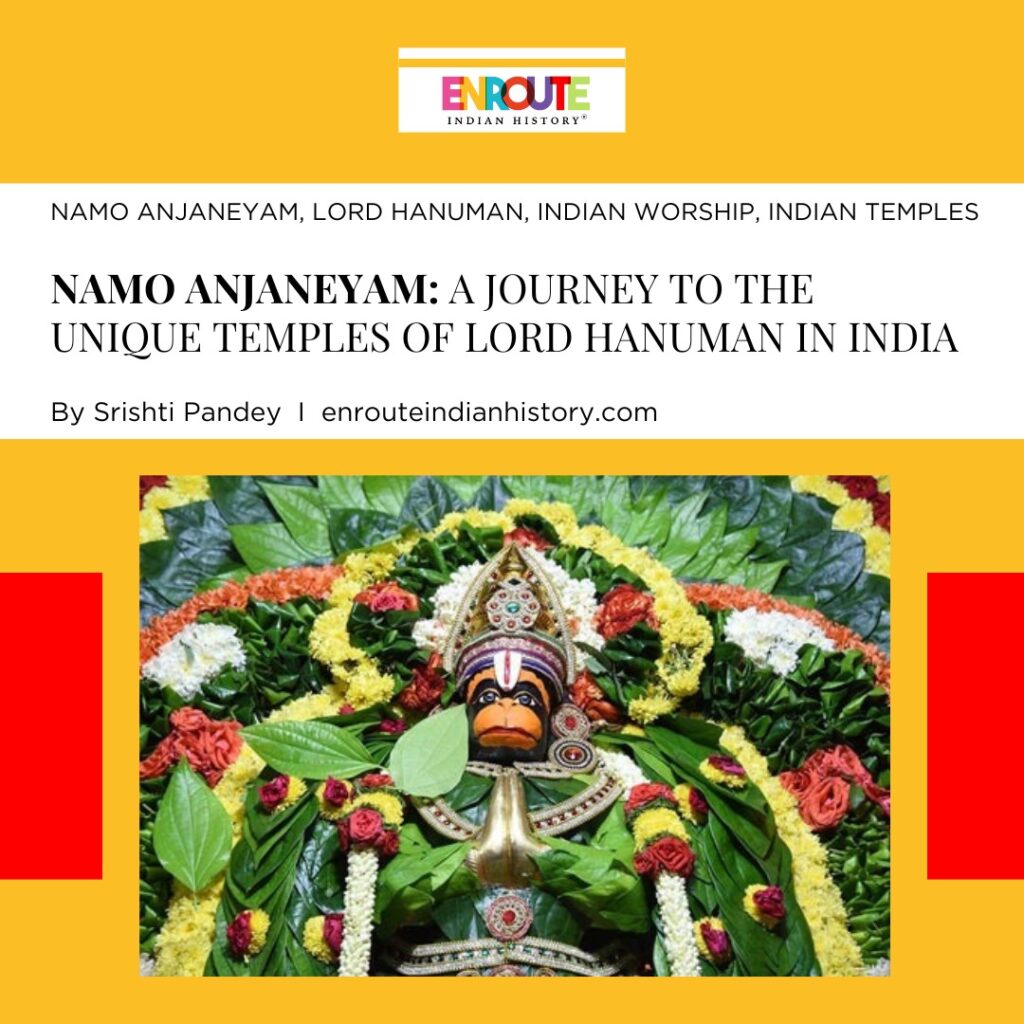
|
Pawan Tanay Sankat Haran, Mangal Murti Roop Ram Lakhan Sita Sahit Hriday Basahu Sur Bhup |
पवनतनय संकट हरन,
मंगल मूरति रूप। राम लखन सीता सहित, हृदय बसहु सुर भूप।। |
| Siya Pati Ram, Jai Jai Ram
Mere Prabhu Ram, Jai Jai Ram |
सिया पति राम, जय जय राम। मेरे प्रभु राम, जय जय राम।। |
These blessed lines from the Hanuman Chalisa are an indication towards the power which Lord Hanuman has when it comes to eliminating the problems in the lives of his devotees. Rightfully he is also known as ‘Sankat Mochan’. A beloved God in the Hindu pantheon, he is a Kimpurusha (they are mystic beings who are half human and half animal). Born to Anjana and Kesari he has various names. After his father he is called Kesari Nandan and after his mother he is known as Anjaneya. The name of Lord Hanuman is also a combination of two Sanskrit words, Hannan (annihilation) and Man (mind). It is believed that Lord Hanuman had the perfect mastery over his mind while being in the perfect body. Also known as “Bajrang Bali”. It means, the strongest one, who has limbs as hard or as tough as diamond. Lord Hanuman is known for his immense strength, unwavering loyalty, and deep devotion to Lord Rama.
Lord Hanuman inspires both, children and adults to become the strongest versions of themselves. The belief in Lord Hanuman can make one feel uplifted and positive even in the grimmest situations. Lord Hanuman assisted Lord Ram in defeating Ravana the king of Lanka and rescue Ma Sita. Parents who seek protection for their children to individuals who need strength, just chanting the name of Lord Hanuman is a cure to all their problems.
There are many Indian temples which are dedicated to Lord Hanuman. From the place where he was born to the place where he entered the netherworld to rescue Lord Ram and his brother Lakshman, there are some powerful and unique Indian temples which are dedicated to the Indian worship of Lord Hanuman. This article is a dedication to the birth of Lord Hanuman. Every year, the birth of Lord Hanuman is celebrated as “Hanuman Janmotsav”. In 2024, this auspicious occasion falls on April 23rd. Lord Hanuman, an ardent devotee of Lord Shri Ram, holds a special place in Hinduism.
This article embarks on a spiritual journey to some of the most unique Indian temples dedicated to Lord Hanuman. These sacred places hold immense significance for devotees and offer glimpses into the rich history and devotion associated with Lord Hanuman.
1 THE ANJANEYA TEMPLE, HAMPI-KARNATAKA
Atop the Anjaneya hill in Hampi at a place called Anegundi stands the Indian Temple called the Anjana Math Temple, the Monkey Temple or the Anjaneya Temple. The devotees climb around 570 steps to reach the temple which commemorates the birth place of Lord Hanuman. There is a debate today about whether this temple is the location of Lord Hanuman’s birthplace or whether it is Kishkindha but in the hearts of the devotees it is here at this Indian Temple of Anjaneya where their beloved Lord Hanuman was born. The icon of Lord Hanuman is carved on a piece of stone. The idol is large and the floating rocks in the glass vessels symbolize the floating Ram Setu (the bridge which took Lord Ram’s army across the sea to Lanka). The view at the top provides the devotees the panoramic view of Hampi and the Tungabhadra River.
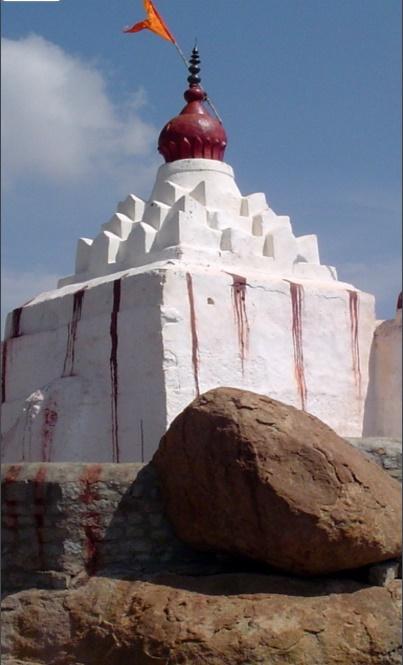
The Anjaneya Temple, Hampi; Karnataka
2 KALE HANUMAN JI TEMPLE (JAIPUR-RAJASTHAN)
In the vibrant pink city of Jaipur at a place called Chandi ki Taksal is the Indian Temple of Lord Hanuman sees a huge turnout of devotees on Tuesdays and Thursday. On the entrance of this temple is a small idol of Lord Ganesh. Within the sanctum sanctorum one finds an idol of Anjini Putra Lord Hanuman carved out of black stone. His mouth is open in a round shape and he is shown standing over Shani Dev.
Chandi ki Taksal was where the minting of silver coins would take place. There is a belief regarding why this idol is black in colour. The belief is that Lord Hanuman was the student of the Sun God or Surya Bhagwan. Once when Lord Hanuman asked him as to what can be his Guru Dakshina or the gift of gratitude in return for the education which his teacher had imparted. Shani Dev is the son of Lord Surya and he said that his son does not listen to him. He requested Lord Hanuman to bring the father and son together and when Lord Hanuman went to meet Shani Dev, he glanced at him making his colour turn black (the glace of Shani is believed to have adverse effects on people).
In majority Indian temples Indian worship is offered to the idol of Lord Hanuman who is in orange colour. However here the idol is black in colour (an important observation also is that in many South Indian Temples the idol of Lord Hanuman is black in colour). The devotees believe that the sacred amulets from this Indian temple help in warding off evil and help in protecting their children.
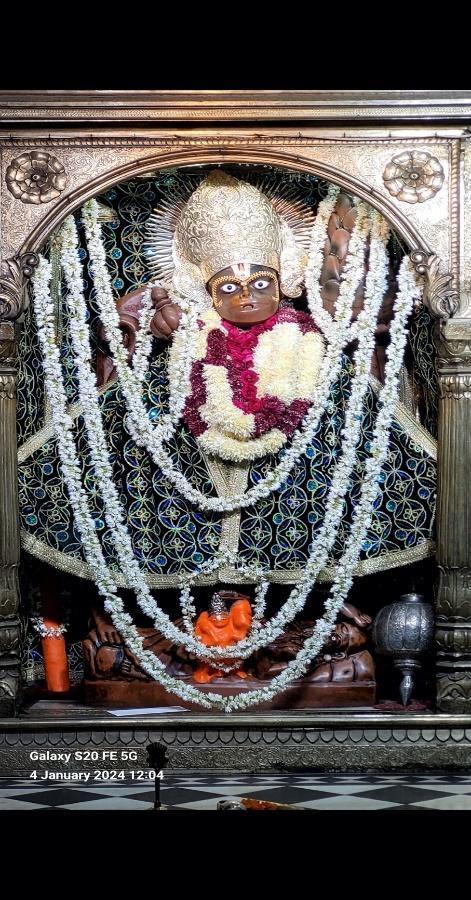
Kale Hanuman Ji Temple, Jaipur-Rajasthan.
3 GILAHRIRAJ MANDIR / TEMPLE, ALIGARH-UTTAR PRADESH
This is a unique Indian Temple dedicated to the worship of Lord Hanuman. Here he is worshipped in the form of a squirrel. There are two versions which are attributed to the construction of this temple. One version states that this temple was constructed by the Pandavs, while the other is that is this Indian temple was constructed by a mahant who belonged to the Nath sect.
The story which is associated with Lord Hanuman taking the form of a squirrel is that at the time of constructing the bridge to Lanka, Lord Hanuman is said to have taken the form of squirrel in order to assist in the construction of the bridge. The squirrel it is said would roll in the sand and shake it off at the place where the bridge was being constructed. Lord Ram had affectionally stroked the back of the squirrel and it is said that the stipes had appeared at that time. Those stripes are believed to be the marks of the lord.
As Gilahraj the lord reminds the devotee that no act of devotion is small and the efforts of the devotees made in good faith hold tremendous significance in the eyes of God.
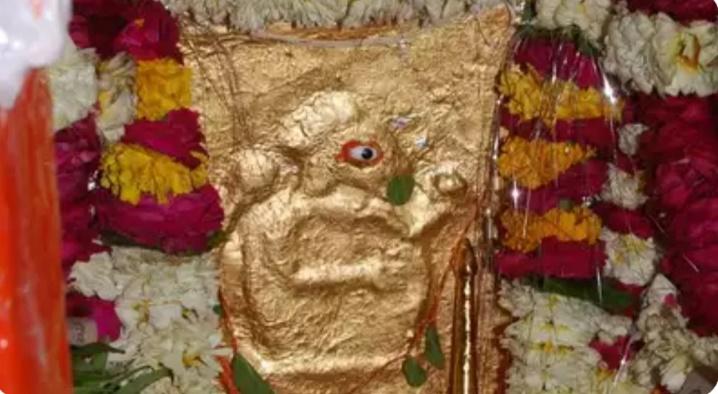
Gilahraj Temple Aligarh-Uttar Pradesh
4 HANUMAN MANDIR, ALLAHABAD
What makes this Indian Temple of Lord Hanuman unique is that this is the only Indian temple of Lord hanuman where he is worshipped in a reclining position. The statue of Lord Hanuman is at least 20 feet long and 8 feet wide. This Indian Temple is located at a distance of one kilometre from the Triverni Sangam (here there is a confluence of rivers Ganga and Yamuna along with the invisible Saraswati).
This Temple of Lord Hanuman is also referred to as ‘Lete’ Hanuman Temple (Lete in Hindi translates as lying down) or as the bada (big) Hanuman temple. The idol is in an underground pit which is about 6 to 7 feet below the ground. The belief is that Lord Hanuman had taken rest here after burning Ravan’s Lanka. This idol is immersed in the water of the holy Ganges. During the monsoons when the water levels rise the holy water it is believed comes to touch the feet of the deity.
There is also a popular legend associated with this Indian Temple. The king of Kannauj did not have children and was advised by the Guru at the Guru ashram that he should get a statue of Lord Hanuman installed in his kingdom. He got this idol from the region around the Vindhayachal Hills and while on his way back he decided to take some rest in Prayag. This is also where his boat broke and that made this idol to get submerged in the water. The dejected king returned to his kingdom without the idol. Many years later when the water receded the idol was discovered by a devotee of Lord Ram called Baba Baligiri ji who was digging up his dhuni. A dhuni is a sacred site represented as a cleft in the ground. A dhuni therefore represents a site of worship dedicated to Shakti.
The king got to know of this discovery and this made him start the worship of the idol and this practise goes back around 600-700 years. Hordes of followers visit this holy Indian temple of Lord Hanuman especially on Tuesday and Saturday.
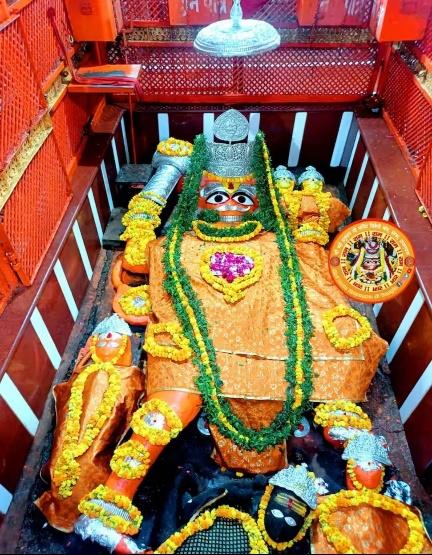
Bade Hanuman Ji. Hanuman Mandir, Prayag.
5 THE DANDI HANUMAN TEMPLE AT BEYT DWARKA, GUJRAT
Lord Hanuman Another unique Indian temple dedicated to the worship of Lord Hanuman is at Beyt Dwarka in Gujrat. The devotes throng for his darshan (physically offering worship to seek blessings). This unique Indian Temple of Lord Hanuman where Indian worship is offered is also known as the Makardhwaj Hanuman temple.
Beyt Dwaraka is the holy site of the reunion of Lord Krishna and his childhood friend Sudama. Five kilometres east of this temple, is this temple where he is worshiped with his son Makardhwaj (he was born to a crocodile out of the tears of Lord Hanuman). Lord Hanuman was unaware that Makardhwaj was his son, and they engaged in combat without recognizing their familial connection.
In the Gujrati language Dandi implies happy. The temple however shows the father and son to be in a joyous mood and they are worshipped in this joyous wood. Therefore, the Dandi Hanuman Temple implies the joyous Hanuman Temple where the father and son are worshipped together.
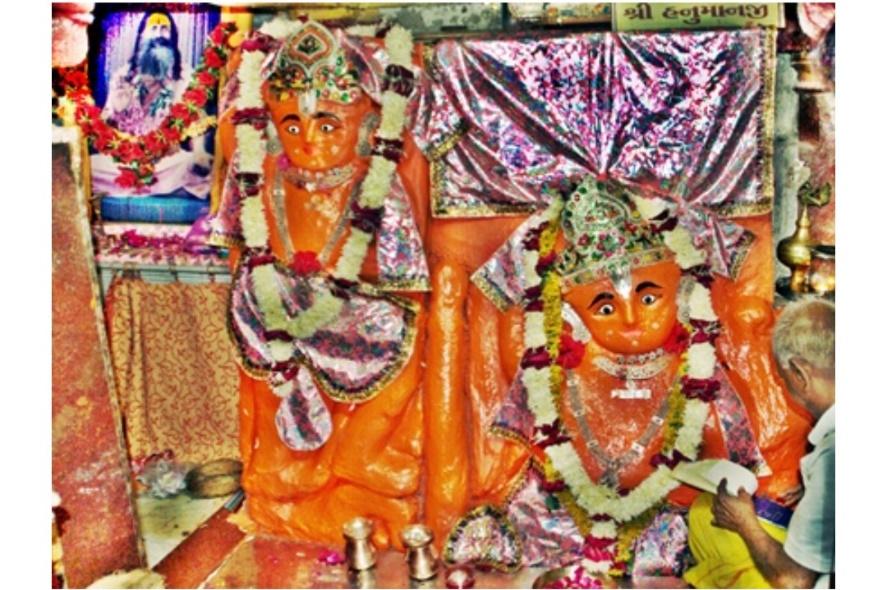
Dandi Hanuman Temple.
6 HANUMAN TEMPLE IN SURAJ KUND, MADHYA PRADESH
Another unique Indian Temple dedicated to Lord Hanuman is at Suraj Kund near the banks of the river Narmada in Madhya Pradesh. The belief associated with this temple is that here the idol changes three times a day owing to the rays of the sun. the belief of the devotees and the temple priests is that the idol of Hanuman is that of a child between 4:00 a.m. to 10:00 a.m.; from 10:00 a.m. to 6:00 p.m. he is an adult and post 6:00 p.m. he becomes an old man.
This statue of Viraj Hanuman at Suraj Kund is considered to be rare. The belief associated with this Indian Temple of Lord Hanuman is that it was here that his Guru or teacher lord Surya meditated on the banks of the river Narmada and he had asked Lord Hanuman to ensure that he should not get disturbed. Post the successful completion of his Tapasya (deep meditation) Lord Surya or the sun God went back to his realm and he asked Lord Hanuman to stay back. Belief is that he started to reside in this very statue which changes its form three times in a day.
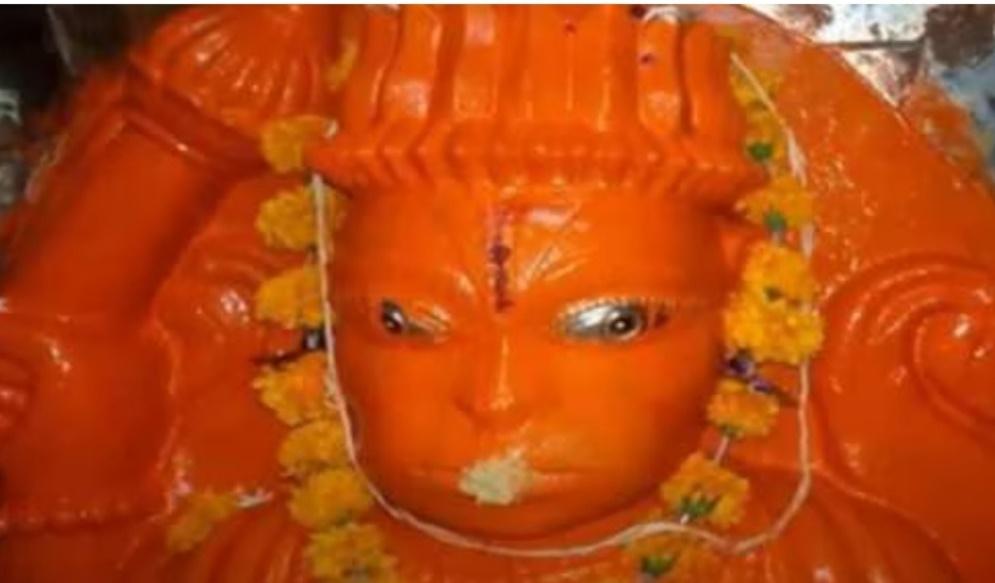
Lord Hanuman at Surajkund, Madhya Pradesh.
7 ULTE HANUMAN TEMPLE, SANWARE, MADHYA PRADESH
This is another unique Temple of Lord Hanuman where the devotees offer worship to an idol of Lord Hanuman who is ‘ulta’ or upside down. Located near the city of Indore at a place called Sanware in Madhya Pradesh. The belief associated with this temple is that it is from this point that Lord Hanuman had entered pataal-lok (the netherworld) when Lord Ram and his brother Lakshman had been abducted by Ahiravan. The idol is upside down and there is always a ‘tilak’ of vermillion.

Ulte Hanuman Ji at Sanware in Madhya Pradesh.
8 SALASAR BALAJI TEMPLE, RAJASTHAN
Located in Salasar, Rajasthan, this temple is renowned for its self-manifested idol of Lord Hanuman. Devotees flock here seeking blessings for courage, strength, and protection. The annual Salasar Fair witnesses a massive gathering of devotees who participate in rituals and seek divine intervention.

Salasar Balaji Hanuman Temple, Rajasthan.
9 CHITRAKOOT HANUMAN DHARA, MADHYA PRADESH
Situated in the Chitrakoot region of Madhya Pradesh, this temple is perched atop a hill. It is believed that it was here that Lord Hanuman had met Lord Ram after burning Lanka and it was here that Lord Ram had helped in cooling him down. Devotees climb a steep flight of stairs to reach the shrine, symbolizing their determination and devotion. The panoramic view of the surrounding landscape adds to the spiritual experience.
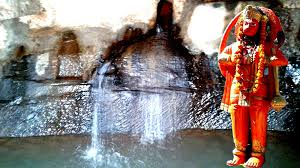
Chitrakoot Hanuman Dhara, Madhya Pradesh.
10 JAKHOO TEMPLE, HIMACHAL PRADESH:
Nestled in Shimla, Himachal Pradesh, the Jakhoo Temple houses a colossal statue of Lord Hanuman. The temple is situated atop Jakhoo Hill, and the climb offers breathtaking views of the city. Legend has it that Lord Hanuman rested here while searching for the Sanjeevani herb during the Ramayana era.

Jakhoo Temple, Shimla, Himachal Pradesh.
11 SANKAT MOCHAN HANUMAN TEMPLE, VARANASI
Located in the holy city of Varanasi, this temple is dedicated to Sankat Mochan, the reliever of troubles. Devotees visit to seek relief from obstacles, ailments, and negative energies. The temple’s serene ambiance and the sound of Hanuman Chalisa create a spiritually uplifting atmosphere.
12 KARYA SIDDHI HANUMAN TEMPLE, BANGALORE:
Situated in Bangalore, Karnataka, this temple is believed to fulfil devotees’ wishes and desires. The Hanuman idol here is adorned with a diamond armour during special occasions. The temple complex also includes a meditation hall and a garden of medicinal plants.

Karya Siddhi Hanuman Temple, Bangalore.
13 PRACHEEN HANUMAN TEMPLE, CONNAUGHT PLACE, NEW DELHI
Hanuman Temple in Connaught Place, New Delhi, India, is an ancient temple and is claimed to be one of the five temples of Mahabharata days in Delhi. The other four temples are the Kalkaji, a Kali temple in South Delhi containing Swayambu (Sanskrit: “self-manifest”) rock Idol, the Yogmaya Temple near Qutub Minar, the Bhairav temple near the Purana Qila and the Nili Chatri Mahadev (Shiva temple) at Nigambodh Ghat outside the walls of Old Delhi.
Pandavas who ruled from Indraprastha lost their kingdom in a dice game to the Kauravas and were exiled for a 12-year term. Hanuman who is considered to be the brother of Bhima as both of them are Vayu’s children, appeared in the forest disguised as a weak and aged monkey. Bhima who was searching for a fragrant flower as asked by Draupadi, found Hanuman lying with his tail blocking his way and, unaware of Hanuman’s identity, scornfully asked him to remove his tail. However, Hanuman told Bhima to lift the tail as he was too weak to do it. Bhima tried hard several times but failed to lift it, in spite of being a man of great strength and it was then he realized that the monkey was none other his own brother.
He apologized for his arrogant behaviour and requested Hanuman to show him his true form. Hanuman was then said to have enlarged himself and showed Bhima the size in which he had crossed the sea to go to Lanka, looking for Sita during the Ramayana period.
The idol in the temple, devotionally worshipped as “Sri Hanuman Ji Maharaj” (Great Lord Hanuman), is that of Bala Hanuman namely, Hanuman as a child.

Pracheen Hanuman Temple, Connaught Place, New Delhi
May these temples inspire devotion, strength, and inner peace as devotees connect with Lord Hanuman’s divine energy.
Namo Anjaneyam is a popular stuti or religious song which is sung while worshipping Lord Hanuman. Lord Hanuman has many popular temples in India. Some notable ones being the Jakhoo Hanuman Temple near Shimla in Himachal Pradesh, the Hanuman temple in Connaught Place in Delhi amongst others. This article has been an endeavour to have taken the readers on a journey to the unique Indian Temples of Lord Hanuman in India.
REFERENCES
- https://www.nativeplanet.com/travel-guide/ten-famous-temples-of-lord-hanuman-in-india-005810.html
- https://timesofindia.indiatimes.com/etimes/trending/in-this-temple-lord-hanuman-is-worshipped-as-a-squirrel/articleshow/109001996.cms
- https://www.tripadvisor.com/Attraction_Review-g304555-d6496127-Reviews-or10-Kale_Hanumanji_Ka_Mandir-Jaipur_Jaipur_District_Rajasthan.html
- https://www.trawell.in/uttar-pradesh/prayagraj/bade-hanuman-temple-lette-hanuman-temple
- https://devbhumidwarka.nic.in/tourist-place/bet-dwarka-dandi-hanuman/#:~:text=Five%20kilometers%20east%20of%20the,is%20unique%20is%20more%20interesting.
- https://www.orissapost.com/lord-hanuman-changes-its-form-three-times-a-day/
- https://www.abplive.com/photo-gallery/states/madhya-pradesh-only-temple-in-its-kind-where-hanuman-ji-is-standing-on-his-head-is-situated-in-sanwer-indore-mp-ann-2376518
- https://www.abplive.com/photo-gallery/states/madhya-pradesh-only-temple-in-its-kind-where-hanuman-ji-is-standing-on-his-head-is-situated-in-sanwer-indore-mp-ann-2376518
- https://www.abplive.com/photo-gallery/states/up-uk-prayagraj-know-the-history-importance-of-hanuman-temple-of-allahabad-2098607
- Kale Hanuman Ji-Photo Credit (Srishti Pandey-author)
- https://studycafe.in/hanuman-jayanti-2023-know-rajasthans-salasar-balaji-ji-who-fulfil-wishes-just-by-offering-coconut-210420.html
- https://www.rewariyasat.com/up/questions-raised-on-the-inauguration-of-ropeway-in-hanuman-stream-of-chitrakoot/26025#google_vignette
- https://kashibanaras.com/sankat-mochan-hanuman-temple/
- https://www.blrhanuman.org/about-us
- https://foursquare.com/v/shri-hanuman-mandir-connaught-place-new-delhi/532705b1498ed7133aff4bae


